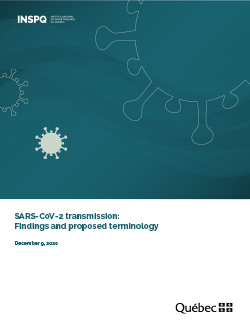SARS-CoV-2 transmission: Findings and proposed terminology
As the SARS-CoV-2 virus drives a worldwide pandemic, our scientific understanding of how it is transmitted is constantly evolving. There is an ongoing debate on various aspects of this process, particularly aerosol transmission. In part, this debate reflects a lack of consensus on the definitions of the terms used to describe the transmission of infectious agents via the respiratory tract.
This text presents a review of the scientific literature focused on the aerosol mode of transmission, but also includes information about other modes of transmission. Authored by a multidisciplinary team, the report seeks to inform the decision-making process of public health authorities, teams of experts, ministerial policymakers, and health and social services facility managers.
Until now, infection prevention and control recommendations have been based on a dichotomous approach, i.e., infection transmission via droplets vs. airborne routes. Yet, the growing body of knowledge on the dynamic aspects of aerosols is paving the way for an approach that suggests transmission is dependent on a continuum of particles ranging in size from drops to aerosols.
The following findings emerge from this multidisciplinary analysis of experimental and epidemiological data:
- SARS-CoV-2 is transmitted primarily when people are in close contact (within 2 meters) for more than 15 minutes.
- The available experimental and epidemiological data support short-range transmission by aerosols, i.e. within 2 meters.
- The risk of SARS-CoV-2 transmission increases in closed, crowded, and poorly ventilated spaces and with prolonged exposure. The data indicate that close contact transmission remains the main route involved. However, the data also suggest that aerosol transmission over longer distances could occur. The maximum distance is uncertain, but is unlikely to exceed a few meters.
- The presence of SARS-CoV-2 RNA and infectious virus in the air does not systematically imply airborne transmission, unlike with tuberculosis. At present, there is no direct evidence unequivocally demonstrating airborne transmission of SARS-CoV-2.
SARS-CoV-2 transmission can be limited by implementing prevention and protection measures in the community, workplaces, and healthcare settings. These measures include:
- Contact restrictions
- Physical distancing
- Mask wearing
- Physical barriers
- Respiratory hygiene and etiquette
- Hand hygiene
- Adequate ventilation
- Environmental cleaning and disinfection
- Application of routine practices and additional infection prevention and control (IPC) precautions in healthcare settings
The information and findings presented in this report will be updated regularly as our knowledge of SARS-CoV-2 transmission evolves.


